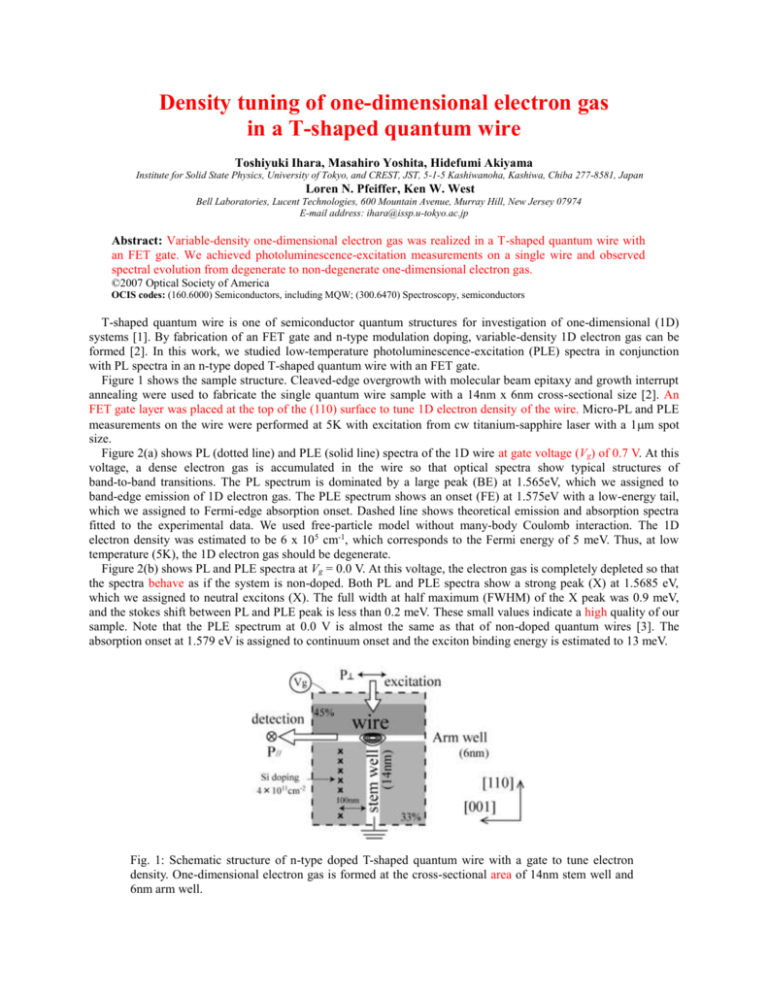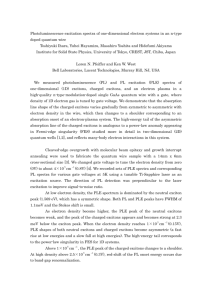Low-Threshold Current-Injection Single-Mode Lasing in T
advertisement

Density tuning of one-dimensional electron gas in a T-shaped quantum wire Toshiyuki Ihara, Masahiro Yoshita, Hidefumi Akiyama Institute for Solid State Physics, University of Tokyo, and CREST, JST, 5-1-5 Kashiwanoha, Kashiwa, Chiba 277-8581, Japan Loren N. Pfeiffer, Ken W. West Bell Laboratories, Lucent Technologies, 600 Mountain Avenue, Murray Hill, New Jersey 07974 E-mail address: ihara@issp.u-tokyo.ac.jp Abstract: Variable-density one-dimensional electron gas was realized in a T-shaped quantum wire with an FET gate. We achieved photoluminescence-excitation measurements on a single wire and observed spectral evolution from degenerate to non-degenerate one-dimensional electron gas. ©2007 Optical Society of America OCIS codes: (160.6000) Semiconductors, including MQW; (300.6470) Spectroscopy, semiconductors T-shaped quantum wire is one of semiconductor quantum structures for investigation of one-dimensional (1D) systems [1]. By fabrication of an FET gate and n-type modulation doping, variable-density 1D electron gas can be formed [2]. In this work, we studied low-temperature photoluminescence-excitation (PLE) spectra in conjunction with PL spectra in an n-type doped T-shaped quantum wire with an FET gate. Figure 1 shows the sample structure. Cleaved-edge overgrowth with molecular beam epitaxy and growth interrupt annealing were used to fabricate the single quantum wire sample with a 14nm x 6nm cross-sectional size [2]. An FET gate layer was placed at the top of the (110) surface to tune 1D electron density of the wire. Micro-PL and PLE measurements on the wire were performed at 5K with excitation from cw titanium-sapphire laser with a 1m spot size. Figure 2(a) shows PL (dotted line) and PLE (solid line) spectra of the 1D wire at gate voltage (Vg) of 0.7 V. At this voltage, a dense electron gas is accumulated in the wire so that optical spectra show typical structures of band-to-band transitions. The PL spectrum is dominated by a large peak (BE) at 1.565eV, which we assigned to band-edge emission of 1D electron gas. The PLE spectrum shows an onset (FE) at 1.575eV with a low-energy tail, which we assigned to Fermi-edge absorption onset. Dashed line shows theoretical emission and absorption spectra fitted to the experimental data. We used free-particle model without many-body Coulomb interaction. The 1D electron density was estimated to be 6 x 105 cm-1, which corresponds to the Fermi energy of 5 meV. Thus, at low temperature (5K), the 1D electron gas should be degenerate. Figure 2(b) shows PL and PLE spectra at Vg = 0.0 V. At this voltage, the electron gas is completely depleted so that the spectra behave as if the system is non-doped. Both PL and PLE spectra show a strong peak (X) at 1.5685 eV, which we assigned to neutral excitons (X). The full width at half maximum (FWHM) of the X peak was 0.9 meV, and the stokes shift between PL and PLE peak is less than 0.2 meV. These small values indicate a high quality of our sample. Note that the PLE spectrum at 0.0 V is almost the same as that of non-doped quantum wires [3]. The absorption onset at 1.579 eV is assigned to continuum onset and the exciton binding energy is estimated to 13 meV. Fig. 1: Schematic structure of n-type doped T-shaped quantum wire with a gate to tune electron density. One-dimensional electron gas is formed at the cross-sectional area of 14nm stem well and 6nm arm well. Fig. 2: Normalized PL (dotted lines) and PLE (solid lines) for 1D quantum wire at the gate voltage of (a) 0.7V and (b) 0.0V. The structures at BE, FE and X are assigned to the band edge, Fermi edge and neutral excitons, respectively. Dashed lines are theoretical emission and absorption spectra fitted to the experimental data with free-particle model calculations. Fig. 3: Normalized PL (dotted lines) and PLE (solid lines) for 2D arm well at the gate voltage of (a) 0.8 V and (b) 0.2 V. As shown above, we observed spectral evolution from the band-to-band structures at Vg = 0.7 V to the excitonic peaks at Vg = 0.0 V. This represents realization of a variable-density 1D electron gas from 6x105 cm-1 to almost zero in our T-shaped quantum wire with an FET gate. By tuning the electron density and the temperature, we can control the degeneracy of the 1D electron gas. It is also notable that we achieved PLE measurement on a single quantum wire of extremely small volume. This was made possible by development of highly sensitive PLE measurement system, where the direction of PL detection was perpendicular to the laser excitation and their polarizations were orthogonal to each other. Thanks to this geometry, we could eliminate the intense laser scattering and improve signal-to-noise ratio of PLE spectra. Setting the target position of the measurement to the arm well, as indicated in the inset of Fig. 3, we also measured PL and PLE spectra of 2D electron systems. Figure 3(a) shows PL and PLE spectra measured for the 2D arm well at Vg = 0.8 V. We observed a PL peak at 1.581 eV, and two PLE peaks at 1.585 eV and 1.593 eV. These structures are analogous to Hawrylak’s model [4]. At Vg = 0.2 V, the 2D electron gas is depleted so that a strong excitonic peak appears at 1.5835 eV in both PL and PLE spectra, as shown in Fig. 3(b). The absorption onset at 1.591 eV is assigned to 2D continuum state. [1] H. Akiyama, M. Yoshita, L. N. Pfeiffer and K. W. West, ”One-dimensional excitonic states and lasing in highly uniform quantum wires formed by cleaved-edge overgrowth with growth-interrupt annealing”, J. Phys.: Condens. Matter 16, S3549 (2004). [2] H. Akiyama, L. N. Pfeiffer, A. Pinczuk, K. W. West, and M. Yoshita, “Observation of large many-body Coulomb interaction effects in a doped quantum wire”, Solid State Commun. 122, 169 (2002). [3] H. Itoh, Y. Hayamizu, M. Yoshita, H. Akiyama, L. N. Pfeiffer, K. W. West, M. H. Szymanska, and P. B. Littlewood, “Polarization-dependent photoluminescence-excitation spectra of one-dimensional exciton and continuum states in T-shaped quantum wires”, App. Phys. Lett. 83, 2043 (2003). [4] P. Hawrylak, “Optical properties of a two-dimensional electron gas: Evolution of spectra from excitons to Fermi-edge singularities”, Phys. Rev. B 44, 3821 (1991).






